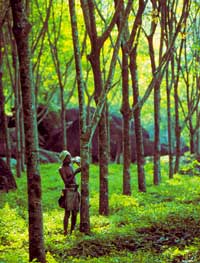Reply To:
Name - Reply Comment
Last Updated : 2024-04-24 14:12:00
 Rubber has been grown traditionally in the Low Country Wet Zone covering the Southwestern, Southern and Central parts of Sri Lanka, though the low and mid elevations in the Intermediate and Dry Zones are also being explored now with varying degrees of success. This tract is however, now reaching a level of saturation for rubber cultivation and the scope of further expansion is very much limited. Therefore, it has become necessary to look for new locations to plant rubber.
Rubber has been grown traditionally in the Low Country Wet Zone covering the Southwestern, Southern and Central parts of Sri Lanka, though the low and mid elevations in the Intermediate and Dry Zones are also being explored now with varying degrees of success. This tract is however, now reaching a level of saturation for rubber cultivation and the scope of further expansion is very much limited. Therefore, it has become necessary to look for new locations to plant rubber. Soil related factors should, therefore, be considered as having a very important bearing on crop performance and crop productivity on different kinds of soils occurring within the same agro-ecological region. Meaningful land use planning for plantation agriculture, therefore, should be based on a proper understanding of the soil-vegetation relationships.
Soil related factors should, therefore, be considered as having a very important bearing on crop performance and crop productivity on different kinds of soils occurring within the same agro-ecological region. Meaningful land use planning for plantation agriculture, therefore, should be based on a proper understanding of the soil-vegetation relationships.
Add comment
Comments will be edited (grammar, spelling and slang) and authorized at the discretion of Daily Mirror online. The website also has the right not to publish selected comments.
Reply To:
Name - Reply Comment
US authorities are currently reviewing the manifest of every cargo aboard MV
On March 26, a couple arriving from Thailand was arrested with 88 live animal
According to villagers from Naula-Moragolla out of 105 families 80 can afford
Is the situation in Sri Lanka so grim that locals harbour hope that they coul